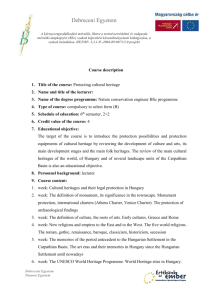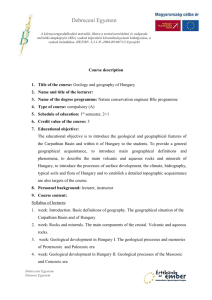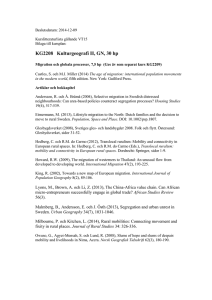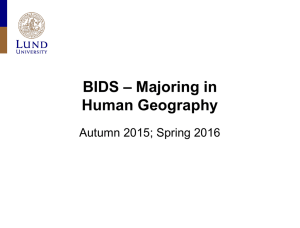Tantárgyi program - Debreceni Egyetem
advertisement
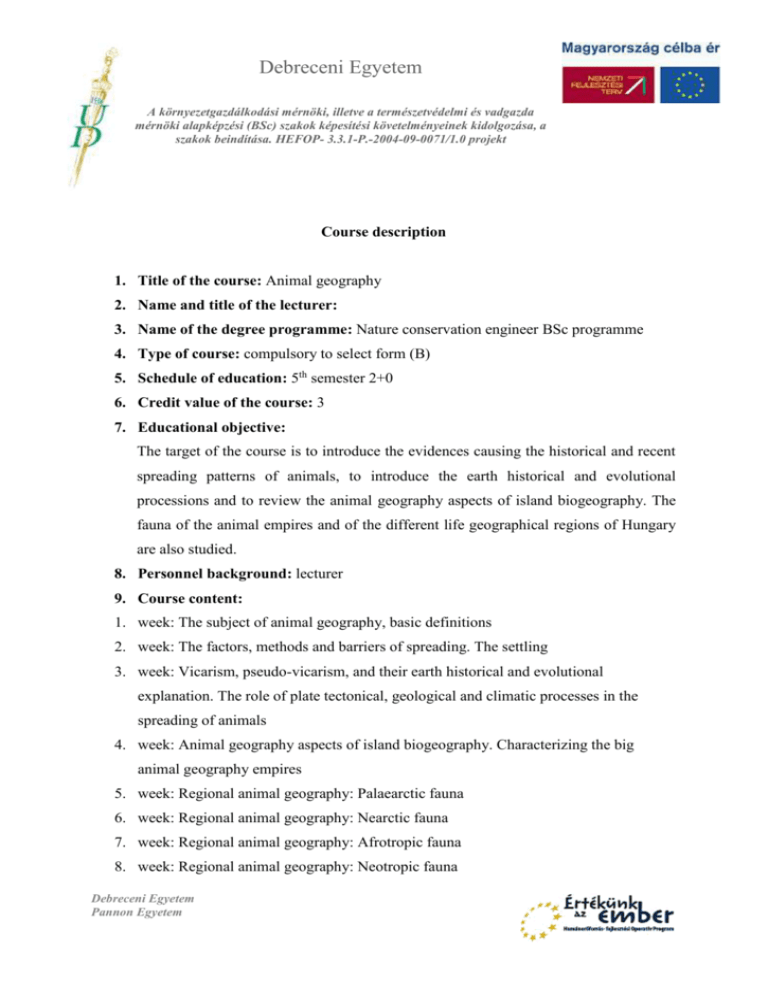
Debreceni Egyetem A környezetgazdálkodási mérnöki, illetve a természetvédelmi és vadgazda mérnöki alapképzési (BSc) szakok képesítési követelményeinek kidolgozása, a szakok beindítása. HEFOP- 3.3.1-P.-2004-09-0071/1.0 projekt Course description 1. Title of the course: Animal geography 2. Name and title of the lecturer: 3. Name of the degree programme: Nature conservation engineer BSc programme 4. Type of course: compulsory to select form (B) 5. Schedule of education: 5th semester 2+0 6. Credit value of the course: 3 7. Educational objective: The target of the course is to introduce the evidences causing the historical and recent spreading patterns of animals, to introduce the earth historical and evolutional processions and to review the animal geography aspects of island biogeography. The fauna of the animal empires and of the different life geographical regions of Hungary are also studied. 8. Personnel background: lecturer 9. Course content: 1. week: The subject of animal geography, basic definitions 2. week: The factors, methods and barriers of spreading. The settling 3. week: Vicarism, pseudo-vicarism, and their earth historical and evolutional explanation. The role of plate tectonical, geological and climatic processes in the spreading of animals 4. week: Animal geography aspects of island biogeography. Characterizing the big animal geography empires 5. week: Regional animal geography: Palaearctic fauna 6. week: Regional animal geography: Nearctic fauna 7. week: Regional animal geography: Afrotropic fauna 8. week: Regional animal geography: Neotropic fauna Debreceni Egyetem Pannon Egyetem Debreceni Egyetem A környezetgazdálkodási mérnöki, illetve a természetvédelmi és vadgazda mérnöki alapképzési (BSc) szakok képesítési követelményeinek kidolgozása, a szakok beindítása. HEFOP- 3.3.1-P.-2004-09-0071/1.0 projekt 9. week: Regional animal geography: Indomalai fauna 10. week: Regional animal geography: Australian fauna 11. week: Regional animal geography: Oceania, Antarctic fauna, and the fauna of the oceans 12. week: Description of the Carpathian Basin regarding animal geography, the origin of its fauna 13. week: Exponents of the Hungarian fauna elements 14. week: Animal geography description the Hungarian landscape units 15. Mode of assessment during the semester: none 10. Type of exam: terminal examination 10. Compulsory practice related to the course: none 13. Compulsory and recommended literature: Udvardy, M. (1983): Dinamikus állatföldrajz. Tankönyvkiadó. Budapest Széky, P. (1989): A Föld állatvilága. Kis állatföldrajz. Mezőgazdasági Könyvkiadó. Budapest Varga, J. and Rácz, I. (1996): Állatföldrajz. Líceum Kiadó. Eger Attenborough, D. (1994): Az élővilág enciklopédiája. GeoHolding Rt. Budapest Fauna Hungariae sorozat vonatkozó kötetei 14. Exam themes: 1. Delineate and describe the passive, active and random spreading. 2. Delineate the barriers of spreading. 3. Describe the leaping and diffuse spreading and the secular migration. 4. Explain the definitions of vicarism and pseudo-vicarism. Delineate their earth historical and evolutional explanation. 5. Delineate the types of islands and the factors affecting the settlement of islands. 6. Reason the particular endangerment of island faunas. 7. Delineate the spreading of marsupial mammals, explain their spreading pattern. Debreceni Egyetem Pannon Egyetem Debreceni Egyetem A környezetgazdálkodási mérnöki, illetve a természetvédelmi és vadgazda mérnöki alapképzési (BSc) szakok képesítési követelményeinek kidolgozása, a szakok beindítása. HEFOP- 3.3.1-P.-2004-09-0071/1.0 projekt 8. Delineate the spreading of struthioniforms, explain their spreading pattern. 9. Delineate the spreading of bears. 10. Delineate the spreading of cats. 11. Delineate the spreading of primates. 12. Delineate the spreading of camels and horse-like animals. 13. Delineate the spreading of rhinoceroses and elephants. 14. Delineate the spreading of cetaceans. 15. Delineate the common features of Nearctis and Palearctis and the reasons of similarity and dissimilarity of their living world. 16. Delineate the fauna of the Palearctis. 17. Delineate the fauna of the Nearctis. 18. Delineate the fauna of the Afrotropis. 19. Delineate the fauna of the Neotropis. 20. Delineate the fauna of the Indomalai region. 21. Delineate the fauna of the Australian region. 22. Delineate the fauna of the Antarctis and the oceans. 23. Delineate the fauna of the Oceania region. 24. Delineate the origin of the fauna of the Carpathian Basin. 25. Delineate the fauna elements of Hungary. 26. Describe the fauna of the South Transdanubian areas. 27. Describe the fauna of the West Transdanubian areas. 28. Describe the fauna of the Danube-Tisza Interfluve areas. 29. Describe the fauna of the North-Hungarian Mountains. 30. Describe the fauna of the Transtisza areas. Debreceni Egyetem Pannon Egyetem
